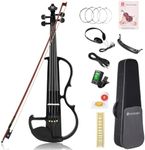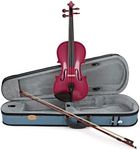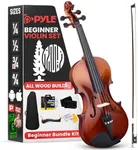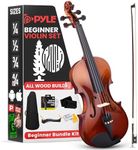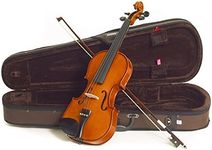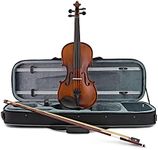Buying Guide for the Best Violins
Choosing the right violin is a personal journey that involves understanding your own needs and preferences. Whether you're a beginner or an experienced player, the right violin can enhance your playing experience and help you grow as a musician. It's important to consider factors such as sound quality, size, and craftsmanship, as these will greatly influence your satisfaction and progress. Take your time to explore different options, and if possible, try out several violins to see which one feels and sounds best to you.SizeThe size of a violin is crucial because it affects playability and comfort. Violins come in various sizes, from full size (4/4) to smaller sizes like 3/4, 1/2, and so on, down to 1/16 for very young children. The right size for you depends on your age, arm length, and hand size. A violin that is too large or too small can hinder your ability to play comfortably and correctly. To find the right size, measure the length from your neck to the middle of your left-hand palm when your arm is fully extended. This measurement will help you determine the appropriate violin size.
Material and CraftsmanshipThe materials used and the craftsmanship of a violin significantly impact its sound quality and durability. Violins are typically made from woods like spruce for the top and maple for the back, sides, and neck. The quality of these woods and how they are crafted together can affect the resonance and tone of the instrument. Higher quality violins often have better craftsmanship, resulting in a richer, more complex sound. When choosing a violin, consider the level of craftsmanship and the reputation of the maker, especially if you're looking for an instrument that will last and grow with you.
Sound QualitySound quality is perhaps the most important aspect of a violin, as it directly affects your playing experience and enjoyment. A good violin should produce a clear, warm, and resonant sound. The sound quality can vary greatly between violins, even those of the same size and material. To assess sound quality, it's best to play the violin yourself or have someone play it for you. Listen for a balanced tone across all strings and a sound that appeals to your personal taste. Your level of experience can guide you here; beginners might prioritize ease of play, while advanced players might look for specific tonal qualities.
Setup and AccessoriesThe setup of a violin, including the bridge, strings, and pegs, can affect its playability and sound. A well-set-up violin will be easier to play and produce a better sound. Additionally, accessories like the bow, case, and shoulder rest are important considerations. The bow should be well-balanced and comfortable to hold, as it greatly influences the sound production. A sturdy case is essential for protecting your violin, and a comfortable shoulder rest can improve your playing posture. When choosing a violin, ensure that it comes with quality accessories or be prepared to invest in them separately.
Brand and ReputationThe brand and reputation of a violin maker can provide insight into the quality and reliability of the instrument. Established brands with a good reputation are often a safer choice, especially for beginners who may not yet have the experience to assess quality independently. These brands typically offer consistent quality and good customer support. However, lesser-known makers can also produce excellent violins, sometimes at a better value. Researching reviews and seeking recommendations from teachers or experienced players can help you make an informed decision.



